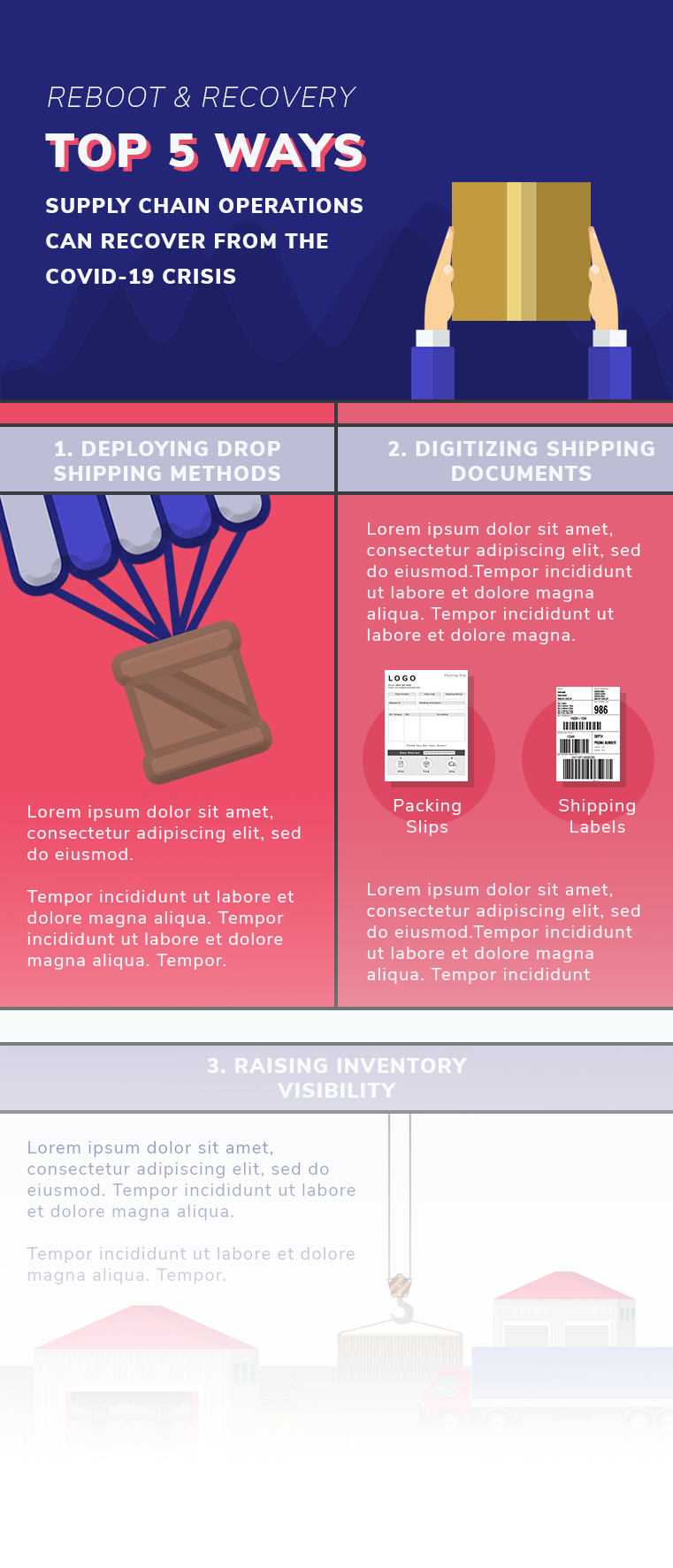5 Ways Supply Chains Can Recover from the COVID-19 Crisis
Identifying Ways Manufacturers and Distributors Can Streamline Struggling Supply ChainsHow the COVID-19 Pandemic is Affecting Supply Chains
In a matter of months, the COVID-19 pandemic has drastically shaken up supply chains in several sectors domestically and internationally. As early as March 2020, 75% of companies reported supply chain disruptions due to pandemic related transit restrictions. With no signs of slowing down, ecommerce order volume has climbed at a rate of nearly 50%. Meanwhile, on-time deliveries for carriers have decreased. The slowdown of supply chains has become a flashpoint for retailers, manufacturers, and distributors.
Of course, the need for lean fulfillment strategies for ecommerce had been on the forefront of many brands’ minds well before the emergence of the Coronavirus. The pandemic simply puts a microscope on an already important issue – flexible supply chain capabilities.
The shuttering of brick and mortar stores, stay at home orders, and sudden shortages of staple goods has radically changed the way consumers buy goods. Surging online sales for retailers like Home Depot, Walmart, Amazon and others continues to put pressure on distributors and fulfillment operations. In order to adapt to these changes, distributors have had to find creative ways to keep up with demand.
The Coronavirus’ Affects on Supply Chains
- Ecommerce order volume has increased nearly 47% since the arrival of COVID-19 (DigitalCommerce360)
- Retailers are taking an average of 1.5 days longer than normal to fulfill orders (Narvar)
- Online shopping is up more than 40% year-over-year since the US’ state of national emergency declaration (Listrak)
- Consumers spent $146.47 billion online with U.S. retailers in the 2020 first quarter, up 14.5% from $127.89 billion for the same period the prior year (US Dept. of Commerce)
Here are a few ways manufacturers and distribution operations can simplify their supply chain in order to meet the rising demands and challenges from the COVID-19 pandemic.
Raising Inventory Visibility
Average warehouse inventory visibility hovers at around 60%. The rise of eCommerce has significantly raised the need for warehouse fulfillment teams to maintain accurate inventory numbers.
If 40% of the inventory in your warehouse is a question mark this can easily lead to messy supply chain problems. Shipping delays, picking/packing errors, and inaccurate or premature stock outs to name a few. In order to properly serve customers, retailers need much more accurate inventory numbers.
Deploying an RFID tracking system can help raise inventory accuracy to above 90%. By affixing inventory or pallets with RFID tags, warehouse teams can run cycle counts in seconds so inventory numbers are always accurate and up to date.
Digitizing Shipping Documents
Even before the COVID-19 pandemic, many manufacturers had begun to take advantage of drop shipping goods for retail partners and wholesalers. But, the more retailers rely on manufacturers to fulfill online orders, the bigger the overhead for said manufacturer. So, of course, it would behoove manufacturers who drop ship to minimize costs. For example, housewares manufacturer, Revman International, found themselves printing out thousands of shipping labels every month. Revman cut out the cost of printing labels by converting shipping documents into PDFs and simply emailing the documents to their partners. This not only streamlined Revman’s label printing work, it saves them thousands each month.
Implementing Track & Trace
Accuracy isn’t the only requirement for warehouses and distributors looking to keep up with the “new normal”. Being able to fulfill orders faster is absolutely vital. Since the beginning of Q2 of 2020 ecommerce fulfillment has struggled to keep up with the protracted demand brought on by the Coronavirus. A simple solution to speed up fulfillments to get a better handle on where inventory is located. With an RFID reader warehouse teams can be empowered to locate items faster and with far less hassle. Also, this allows for more effective put away as inventory is brought in or returned.
Administering Priority Picking
The Coronavirus pandemic has forced many warehouses and distributors to prioritize outbound shipments so life sustaining goods are not delayed. But, just how can this be done in an effective, sustainable way? One simple solution for this is to color coordinate pick lists for your fulfillment team. This can easily help handlers identify the items that need to go out sooner. More sophisticated solutions can be deployed with the right WMS (warehouse management system) such as pick location sequencing, which allows managers to maximize valuable warehouse space.
Automating Shipping & Receiving Validation
For most warehouses and distribution centers, the average picking error rate is around 2%. This constitutes about a 10% loss of profits. When speeding up shipping operations, an increase in errors is a distinct possibility. Proper warehouse organization can become less stringent, while outbound shipping validation often decreases. This is a compounding problem in the age of online shopping since so many distributors and manufacturers now drop ship directly to consumers for retailer partners. To mitigate shipments errors, warehouse teams can install conveyor shipping validation tools. An RFID enabled validation tool can catch outbound and inbound shipping errors without the cumbersome task of opening up packages.
It’s impossible to know when major crises and challenges will arise. That’s why it is so important to be considering supply chain improvements. What better time than now to start thinking outside the box to improve your warehouse’s fulfillment speed and accuracy.





